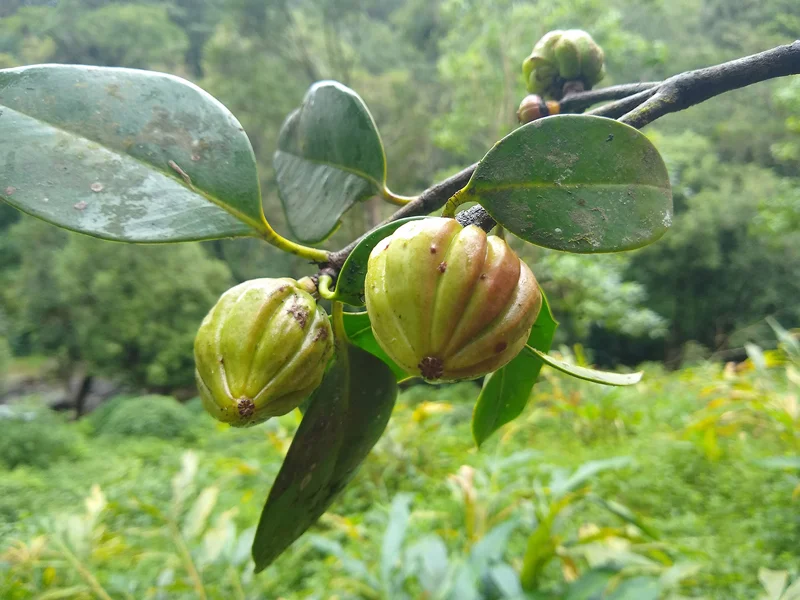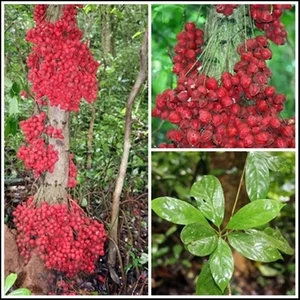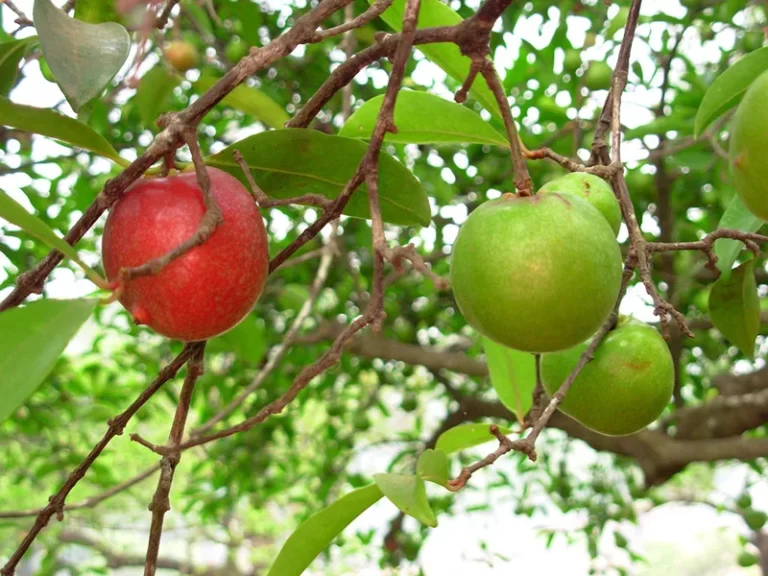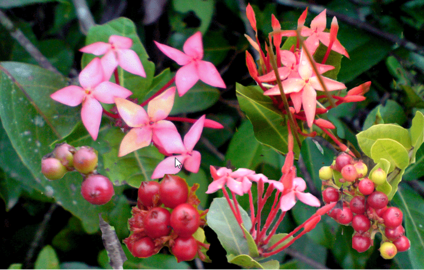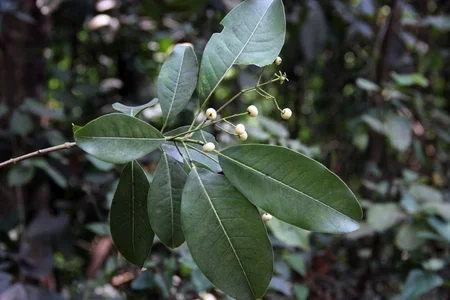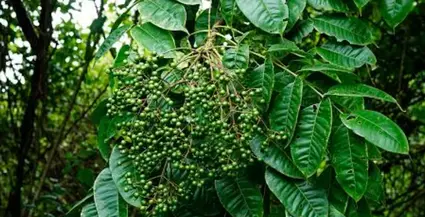Garcinia Cambogia or Kudampuli
Malabar Tamarind or Kudampuli(In Malayalam) or Uppage(In Kannada)
Garcinia gummi-gutta is a tropical species of Garcinia native to South Asia and Southeast Asia. Common names include Garcinia Cambogia (a former scientific name), as well as brindle berry, and Malabar tamarind.[3] The fruit looks like a small pumpkin and is green to pale yellow in color. This is medium sized dioecious trees. Leaves roundish-eliptic. Male flowers yellow, in axillary and lateral fascicles. Female flowers solitary, terminal. Fruit conical, 4-5 ridged. Seeds 4-5
Although it has received considerable media attention purporting its effects on weight loss, there are reports of liver toxicity associated with the Hydroxycut commercial preparation containing the fruit extract, with clinical evidence indicating it has no significant effect on weight loss.
Garcinia Cambogia is grown for its fruit in Southeast Asia and South Asia. Garcinia gummi-gutta is one of several closely related Garcinia species from the plant family Clusiaceae. With thin skin and deep vertical lobes, the fruit of G. gummi-gutta and related species range from about the size of an orange to that of a grapefruit; G. gummi-gutta looks more like a small yellowish, greenish, or sometimes reddish pumpkin. The color can vary considerably. When the rinds are dried and cured in preparation for storage and extraction, they are dark brown or black in color.
Phytochemicals
Although few high-quality studies have been done to define the composition of the fruit, its phytochemical content includes hydroxycitric acid which is extractable and developed as a dietary supplement. Other compounds identified in the fruit include the polyphenols, luteolin, and kaempferol.
Common Names and Other Details
In the Malabar Coast, it is known as Kudampuli in Malayalam, Uppage in Kannada and in Tamil speaking areas of Sri Lanka and India, it is called goraka.
Family: Clusiaceae
Distribution: Restricted endemic of Wayanad and Nilgiri hills
Conservation status: Not Evaluated
Uses: Used as an edible fruit in curries

Weight loss claims
In late 2012, a United States celebrity doctor, Dr. Oz, promoted Garcinia Cambogia extract as “an exciting breakthrough in natural weight loss”.[11][12] Dr. Oz’s endorsements of dietary supplements having no or little scientific evidence of efficacy have often led to a substantial increase in consumer purchases of the promoted products.
While it has received considerable media attention purporting impact on weight loss, the evidence for Garcinia Cambogia supports no clear effect,[3][4][13][14] while gastrointestinal adverse events were two-fold more common over the placebo in a 2011 meta-analysis, indicating the extract may be unsafe for human consumption. Adverse events associated with use of such supplements (“side effects”) — especially, liver toxicity, as well as gastrointestinal issues — led to one preparation being withdrawn from the market.
Adverse effects
In addition to possible liver damage, hydroxycitric acid can cause dry mouth, nausea, gastrointestinal discomfort, and headaches.
At least one other published medical study seem to contradict the above assertion:
The structure, mechanism of action, long history of the use of Garcinia/HCA and comprehensive scientific evidence had shown “no observed adverse effect level (NOAEL)” at levels up to 2800 mg/day, suggesting its safety for use.
Drug interactions
There is potential for Garcinia Cambogia to interfere with prescription medications, including those used to treat people with diabetes, asthma, and clotting disorders.[4]
Culinary
When the fruit is sun dried for several days, it becomes black with a shriveled body
Garcinia gummi-gutta is used in cooking, including in the preparation of curries to add a sour flavor.[4] The fruit rind and extracts of Garcinia species are used in many traditional recipes used in food preparation in Southeast Asian countries. In the Indian Ayurvedic medicine, “sour” flavors are said to activate digestion. The extract and rind of G. gummi-gutta is a curry condiment in India. It is an essential souring ingredient in the southern Thai variant of kaeng som, a sour curry.
Malabar Tamarind, scientifically known as Garcinia Cambogia, is a traditional spice available particularly in tropical regions. The local name of this spice is ‘Kudampuli’. It is specifically used to add sour taste in the authentic Kerala fish curries. Unlike its name Malabar tamarind, it is a small round-shaped fruit which resembles miniature of pumpkin. The reason behind sour taste is the presence of a hydroxycitric acid which adds the sour flavor to the fruit.
Kudampuli is used in dry form like any other Indian spice. It goes through a long procedure to reach that form. The ripened fruit is plucked from vine and sun-dried. After that, it turns black and leathery in appearance. It is an exclusive element in Kerala cuisine which adds a punch of sourness to the creamy flavour of coconut. One can get pure Garcinia Cambogia from traditional markets and the villages where best Garcinia Cambogia vines are situated.
Health benefits of Kudampuli
If you thought that spices can only activate your taste buds, then it is time to look at the other side of the story. Kudampuli is not just a flavouring agent; it possesses some amazing health benefits too. Due to this, Garcinia Cambogia is also an integral part of Kerala Ayurveda. You can see its name in the content of many Ayurvedic medicines. Now, that we are so much into the health benefits of this spice, let us explore some and feel good about it.
Appetite control
One of the major functions of Kudampuli is to control your appetite. The acidic nature of the spice keeps you full as long as your body does not need an external food uptake. In this way, you can keep a check on all the extra calories that you consume every day.
Helps you with digestive ailments
We already know that bacteria’s and worms do not survive under low pH conditions. Hence, Kudampuli clearly promotes your digestive health by preventing the growth of harmful intestinal parasites. In this way, it becomes easy to get rid of all the issues related to your digestion. The spice ensures that your bowel activity is improved. You can recover from problems like constipation, acidity, and ulcers easily.
Relieves from problems arising due to arthritis
The rheumatoid disorders and weakness of bone is an emerging problem of today. Kudampuli is a wonderful medicine for every woman suffering from polyarthritis and inflammation of joint. Unlike other acidic agents, this one keeps you protected from such age-related health problems.
Garcinia Cambogia’s weight loss properties
The major concern of present day is obesity. People are investing money in gyms and adopting difficult diet patterns to do away with the lipids. Little did we know that Kudampuli can reduce 2 kgs in a month. The hydrocitric acid is actually a significant content of weight loss products. Why not consume it through its prime natural source?
Reduces cholesterol
Being acidic in nature, Kudampuli increases fatty acid metabolism. It, in turn, reduces the level of bad cholesterol in the blood. Due to this property, it has successfully managed to save consumers from heart and liver diseases.
Boosts your immunity
Due to their property which supports the metabolic activities of our body, it readily elevates the immunity power. Further, it keeps your organs healthy and prolongs the effect of ageing.
Detoxification of alcohol
It is an extremely helpful ingredient if you want to protect your liver from toxins. Moreover, it fights the damaging effects of alcohol on the liver. It also prevents your hepatic cells from becoming stiff.
Solves the issues of female reproductive tract
As we all know that work stress and an unhealthy routine is causing a lot problem in the reproductive system. But no worries, this one natural ingredient can neutralize the extreme alkaline environment of the uterus. This further supports the growth of harmful microorganisms and keeps you safe from uterine diseases.
Relief from bad breathe
Malabar Tamarind is very helpful in preventing the odor of your buccal cavity. Unlike the usual tamarind, you will not feel sensitivity while consuming Kudampuli. In fact, it keeps your teeth healthy, shiny, and free from parasites of an oral cavity.
Precautions to be taken while using Kudampuli
We all understand that too much of anything can prove to be harmful. Hence, there are certain points which you need to keep in mind while consuming Kudampuli.
1, Do not use it continuously for a prolonged period of time. It may affect the functional cells of your testicle.
2. Using in excess may lead to acidity problems by triggering the cells present in your stomach.
3. Also, it may suppress your hunger in an abnormal way if you consume it in excess.
4. In the light of all the aforesaid benefits of Kudampuli or Malabar Tamarind, we can come to the conclusion that it is not just a kitchen ingredient. It is an amazing spice with medicinal values. One should bring home this magical ingredient and make use of it for a healthy living.
How to use Kudampuli?
There are different ways in which people cook and mix this spice with their respective dishes. Given below are some of the traditional ways of using this ingredient.

Kerala Style Fish Curry using Kudampuli
In Kerala, almost every household has its own fish curry recipe which can be considered an heirloom recipe.
I’ve often heard people saying they at least need a whiff of fish curry to have rice, no wonder fish is a must-have item in Kerala oonu (meals).
Though the fish curry varies throughout Kerala, I feel the base flavor is somewhat similar. It’s like we all are traveling toward a common destination but taking different routes!
The basic flavor composition of the curry is spiciness and tanginess. How you chose to add it to the curry makes the difference. It can be Chilli powder, pepper powder or green Chilli or dried red Chilli paste for the heat and it can be Kudampuli (gamboge) or tamarind, or tomato for the tanginess.
Then comes the “coconut” part of it. There is fish curry with or without coconut. If you decide to go with coconut, how do you want to use it… as coconut milk or coconut paste, or roasted coconut.
The medium you use for the spice and tanginess, the use of coconut, all these different things may seem trivial, but all these tiny little nuances are what make your fish curry your family heirloom!
So, here is another one for you to try out. Here we use both tomato and Kudampuli with coconut milk.
Give it a try and let me know what you think? Also, am more than happy to hear about your “secret” family recipe for fish curry,
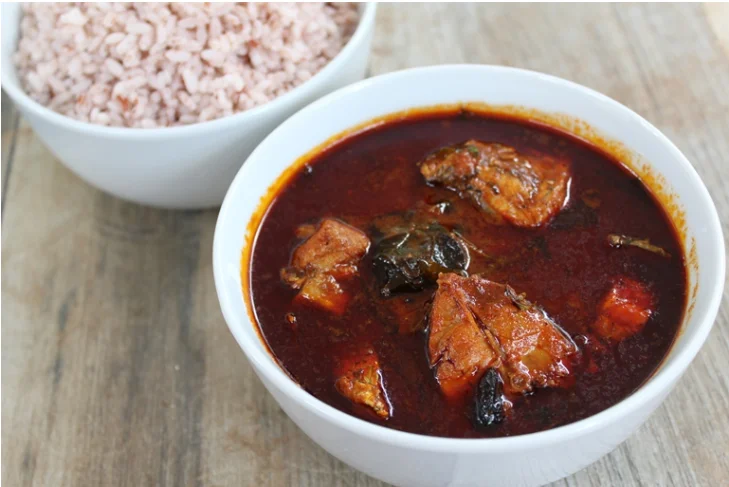
Recipe for Kudampuli Fish Curry
You need to soak dried Kudampuli it in normal or warm water for few minutes and then add the water to your dish. It will provide a hint of sourness to your dish. You can also add the soaked spice in fish curries. It increases the sourness quotient of your favorite curry. Kudampuli can be added directly to the dish in dried form if you need punchy flavor in your dish.
Ingredients
1. 250 grams Fish (refer notes)
2. 1/4 tsp Mustard seeds
3. 4-5 (a pinch) Fenugreek seeds
5. 6-8 Small/pearl onion, sliced
6. 2 tsp, each Crushed ginger & garlic
7. 2 heaped tsp Kashmiri Chilli powder
8. 3 tsp Coriander powder
9. 1/2 tsp Turmeric powder
10. 1/4 – 1/2 tsp Pepper powder
11. 1 small – medium Tomato (pureed)
12. 2 pieces Kudampuli (gamboge) (soaked in 2 tbsp hot water for 10-15 mins)
13. 1/2 cup Thick coconut milk
14. Salt
15. 1 stalk Curry leaves
16. 1.5 tbsp + 1 tsp + 1 tsp Coconut oil
Instructions
1. Mix together Kashmiri Chilli, coriander, turmeric, and pepper powder with 1 tsp oil and 2 -3 tbsp water to a thick paste. Keep it aside.
2. Heat oil (1.5 tbsp) in a clay pot/wide pan. Add mustard, fenugreek seeds, and half of the curry leaves. Let it crackle.
3. Add sliced pearl onion and crushed ginger & garlic. Cook till pearl onion becomes golden brown in color, 4-5 mins.
4. Add the spice powder paste. Mix well and cook for 3-4 mins or till the oil starts appearing.
5. Add pureed tomato and 1/3 cup water and salt. Mix well and bring it to a boil. Reduce the flame to the lowest and add soaked gamboge (Kudampuli) along with the water. Mix well.
6. Add cleaned fish pieces. Rotate the pan and make sure the pieces are covered in the gravy. Cover and cook for 15 – 20 mins, till the fish is almost done.
7. Once the gravy becomes thick and the fish is almost cooked, add thick coconut milk. Rotate the pan gently and let it cook for another 5 mins on the lowest flame. Remove from fire.
8. Drizzle some coconut oil on top, add the remaining curry leaves and let the curry rest for half an hour for the flavor to settle in.
Notes
1. You can use King/Seer fish (neymeen) for this recipe. You can use any meaty kind of fish here.
2. After adding the fish pieces, it’s best to rotate the pan to mix the gravy and fish.
3. Also, you can do a tempering in the end with 3 sliced pearl onions, 1/4 tsp mustard, 1-2 dry red Chilli, and curry leaves. Add it to the fish curry.
Go to Tulu News Page to read more about Tulu Nadu News, Events etc.
Go to Our Partner Website to book Self Drive Cars to drive in Mangalore, Udupi and Kasargod

